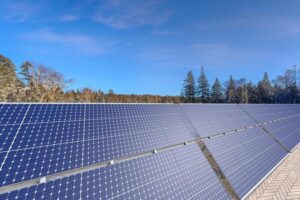Regardless of the setting, the solar panel will tilt (the tilt angle is 90 ° between the surface of the solar panel and the sunlight) to face the sun. That’s because they convert energy from sunlight, so whether on the roof or on the ground, solar panels need to be exposed as much as possible to absorb sunlight.
Undoubtedly, solar panels are more efficient in high-altitude areas. In addition, unlike sea level, they are more easily exposed to solar radiation and can better convert energy into electrical energy for our daily activities.

Is solar energy more effective in high-altitude areas?
Solar panel systems are one of the highest sources of clean energy for power generation, but typically they are installed at sea level. Some people may wonder if solar energy is more effective in high-altitude areas? The basic reasoning will make you think it should be because it is closer to the sun, but it will help us understand more that sunlight emits electromagnetic radiation, also known as solar radiation, which is absorbed by the cells in solar panels to generate energy. However, sometimes this radiation is blocked by various factors such as dust, dirt, or snow, which hinders the full utilization of solar panels. On the other hand, high-altitude areas have fewer atmospheric barriers and obstacles, making them work better in high-altitude areas. Usually, increased exposure to solar radiation leads to an increase in the generated voltage output, unintentionally improving efficiency. This is highly likely because at higher altitudes, we receive more direct radiation and less diffuse radiation.
How to improve the performance of solar panels at high altitudes?
To understand how high altitude can improve the performance of solar panels, it is necessary to understand what hinders the full performance of ground solar panels. So, let’s understand why solar panels cannot achieve their maximum performance on the ground.
1. Weather
Several weather conditions have different effects on the performance of solar panels. When the sun is shining brightly, contrary to popular belief, when the surroundings are too hot and the temperature is too high, the performance of solar panels will be greatly reduced. They depend on the amount of sunlight absorbed by the panels, not the temperature around them. On the other hand, solar panels do not generate electricity during periods of rain, snow, and hail storms.
2. Shadow
Any shadow on the solar panel can damage the efficiency of the panel, causing a decrease in system output. Shadow may not necessarily be a cloudy sky, it may be something that blocks solar panels from being exposed to sunlight. Therefore, when installing a solar panel system, the first step is to ensure that there is nothing obstructing the solar photovoltaic modules in the area. For example, trees, satellite antennas, tall buildings, etc. should not obstruct your solar panels.
3. Low maintenance
Over time, dust, dirt, or debris may accumulate on solar panels. Therefore, it is assumed that solar panels are not regularly cleaned or maintained. In this case, the efficiency of the solar panel may decrease.
In summary, we have seen the factors that affect low altitude solar panels and prevent them from achieving maximum performance, and the performance of solar panels in high altitude areas will be improved.
conclusion
Solar panels are more efficient in high-altitude areas because the ultraviolet rays of the sun increase with the increase of altitude in the atmosphere. This is due to the reduction of air molecules, emissions, etc., and solar panels receive more sunlight.If you want to know more about solar panels, please contact us, the solar panel manufacturer – Huanqi Technology (Shenzhen) Co., Ltd.




